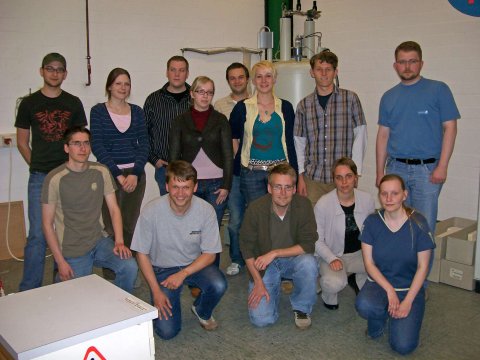Report of the 7. DMG Shortcourse "Applications of Solid State NMR Spectroscopy in the mineralogical and geoscientific research "
in Bochum from 29. May - 01. June 2007

The workgroup NMR spectroscopy of the Ruhr University Bochum around Dr. Michael Fechtelkord invited to attend the Shortcourse “Application of Solid State NMR Spectroscopy in Mineralogy and GeoScience” between May 29th and June 1st into the Ruhr Area. Participants from all areas, from Bochum as well as Copenhagen and Innsbruck came to visit the course. In this year it was new that students, who successfully participate in a final examination, can gain 3 ECTS credit points.
With eleven participants and a PhD-student of the workgroup, who supported the participants during the course the group was complete at the morning of May 29th. Even if there were still some tired faces, due to partly long journeys, the morning started with the introduction to the topic of Solid State NMR spectroscopy. In this morning first a level-adjusting of knowledge for each participant was carried out, because some of the attendees were new to the field while others were already active in the field. After lunch and a detailed view from the department on the Ruhr valley by the foreign class participants the first measurements of the 1H spin lattice relaxation and dynamics of tetramethylammoniumiodide could be accomplished. Following detailed evaluation of the received data the group proceeded to a more convenient part. Regional differences and the meaning the Eurovision song Contest was discussed in a nice pub at the end of the first course day.
The second day was marked by the indication of different interactions like the magnetic dipolar interaction or the chemical shift anisotropy and how these can be averaged out by the MAS (Magic Angle Spinning) technique. The theory was then practiced using a phlogopite sample. At the end of the second short course day different experimental spectra were fitted with the WinFit program package.
On the third day of the course the cross polarization technique and the application on a kaolinite sample was the main topic. After detailed elaboration of this subject the participants enjoyed a bowling evening accompanied with interesting and lively exchange of ideas.
The last short course day was dedicated to the quadrupolar interaction and the application of SATRAS (Satellite Transition Spectroscopy). In the late afternoon the participants left Bochum to travel home. At this point we would like to thank Michael Fechtelkord and his PhD student Ramona Langner for the good support during the course, the hot coffee and answering of every arising question whether before or during the course.
Anna Lena Gritzuhn,
Kiel


